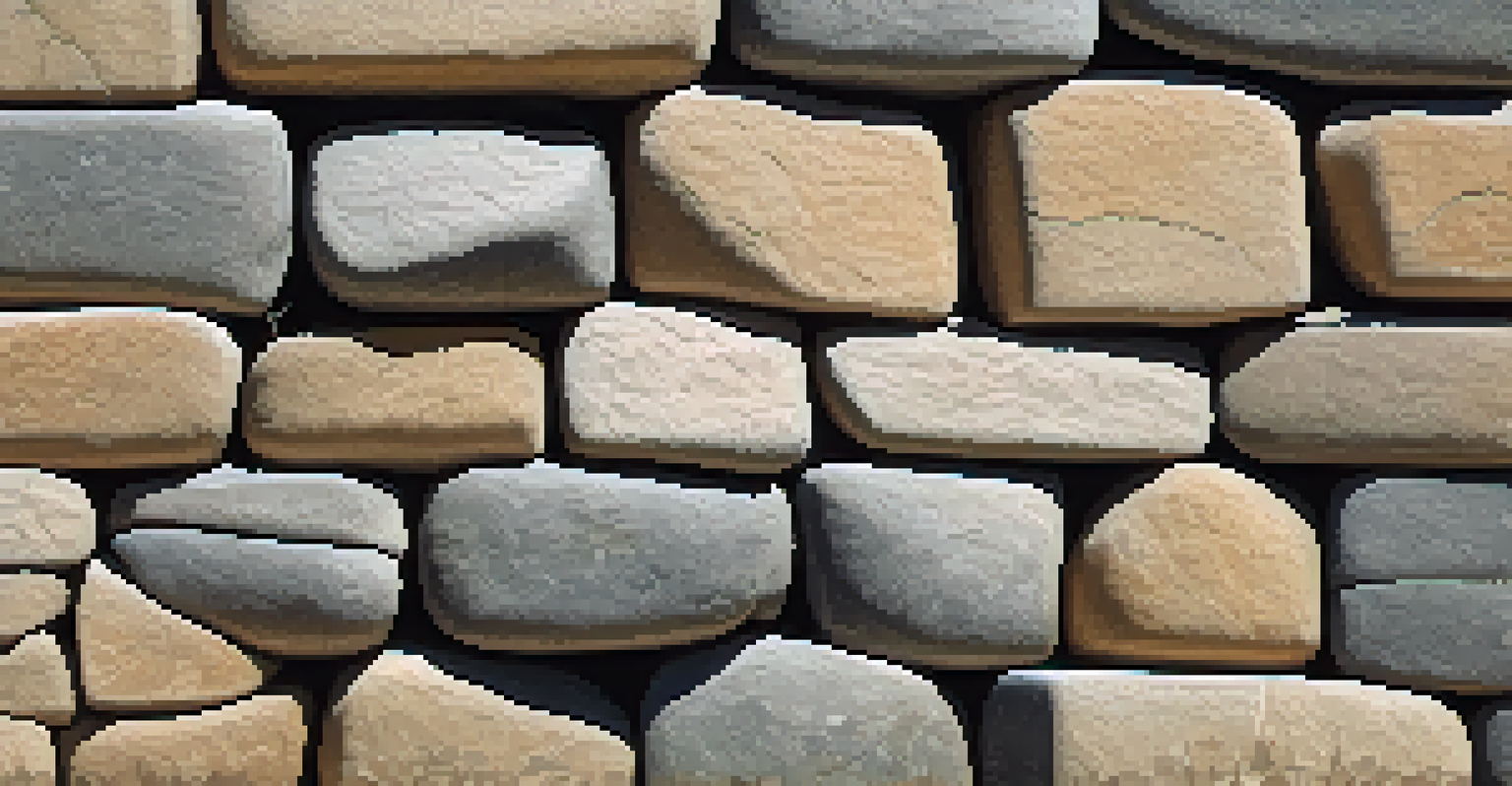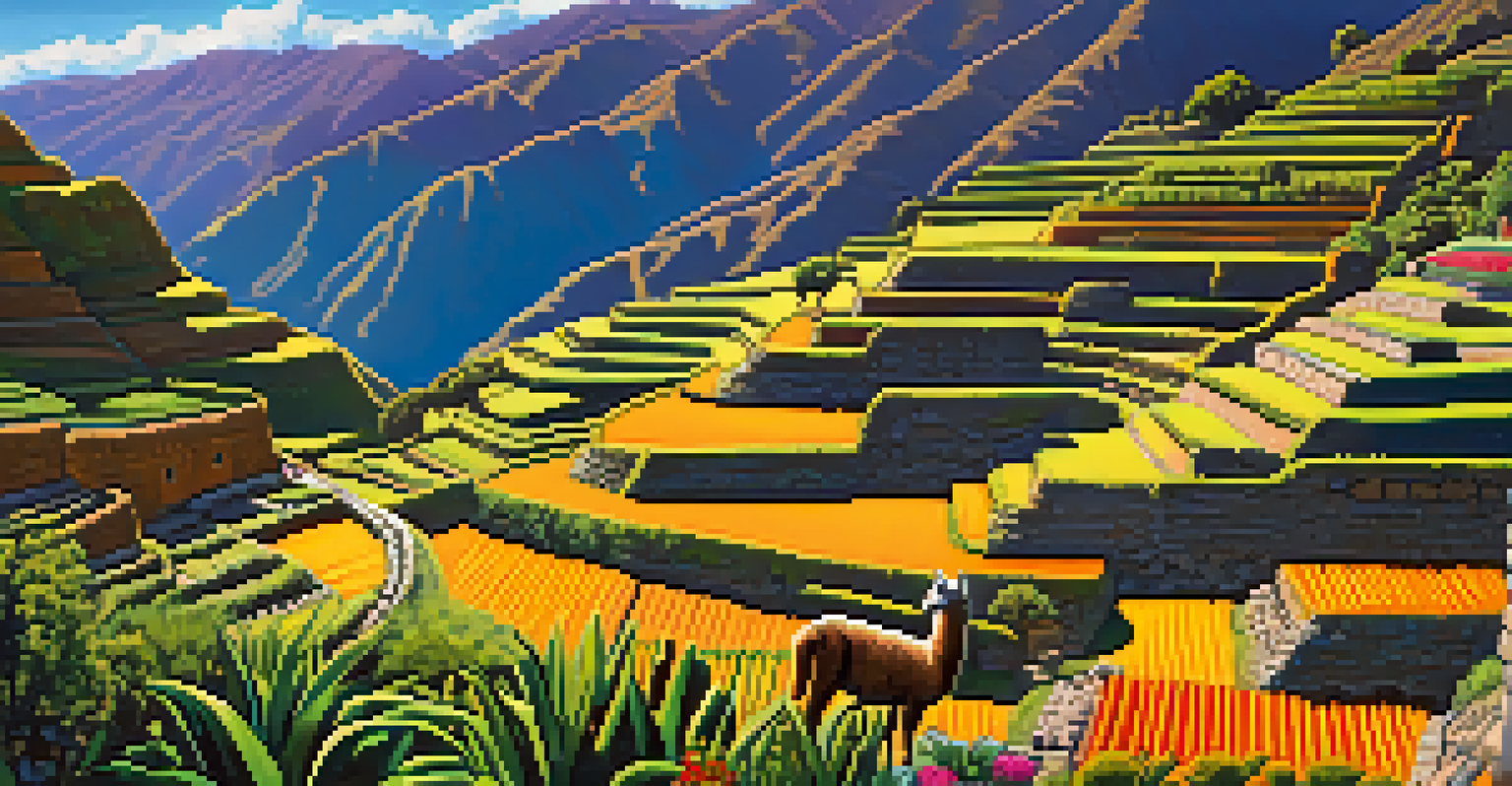Inca Architecture: Techniques and Styles from Ancient Peru

The Significance of Inca Architecture in Ancient Peru
Inca architecture is not just about impressive structures; it reflects the culture, values, and technological prowess of the Inca civilization. Stretching across the rugged terrain of the Andes, these edifices served as more than just homes; they were temples, fortresses, and administrative hubs. Each building tells a story about the people who built them and their connection to the land.
Inca architecture is a reflection of their values, beliefs, and the environment they inhabited.
The Incas believed in a harmonious relationship with nature, which is evident in their architectural choices. They used local materials, aligning their structures with the surrounding environment, ensuring both durability and sustainability. This respect for nature transformed their architecture into a living part of the landscape, rather than an imposition upon it.
Moreover, the grandeur of Inca architecture can be seen in iconic sites such as Machu Picchu and Sacsayhuamán. These locations not only showcase architectural ingenuity but also embody the spiritual and political might of the Inca Empire, making them crucial to understanding the civilization's legacy.
Key Materials Used in Inca Architecture
One of the distinguishing features of Inca architecture is the use of local materials, primarily stone. The Incas were skilled stone masons, often utilizing granite and limestone, which were abundant in the Andean region. This choice not only ensured the strength of their structures but also allowed them to blend seamlessly with their natural surroundings.

The technique of dry stone construction is particularly noteworthy; it involves fitting stones together without the use of mortar. This method not only provided structural integrity but also allowed buildings to withstand the region's frequent seismic activity. The precision with which these stones were cut and placed is a testament to the Incas' advanced engineering skills.
Inca Architecture Reflects Culture
The architectural achievements of the Incas embody their cultural values, technological prowess, and harmonious relationship with nature.
In addition to stone, the Incas also used adobe, a mixture of clay, straw, and water, especially in lower-altitude regions. This versatile material allowed for the construction of homes and other structures that were both functional and insulated against temperature fluctuations, showcasing the Incas' adaptability and resourcefulness.
Innovative Inca Construction Techniques
The Incas employed several innovative construction techniques that set their architecture apart from other ancient civilizations. One of the most remarkable was the use of terracing, which involved creating flat areas on steep slopes for agriculture and building. This not only maximized arable land but also prevented soil erosion, showcasing their understanding of environmental management.
The Incas were masters of their environment, creating structures that harmonized with the landscape while showcasing their engineering prowess.
Another key technique was the use of corbel arches in doorways and windows, which provided both strength and aesthetic appeal. Unlike traditional arches, corbel arches are formed by stacking stones in a staggered manner, allowing for larger openings without compromising structural integrity. This technique is evident in many Inca structures and adds to their unique visual character.
The Incas also developed sophisticated drainage systems to manage water flow in their cities. By constructing channels and aqueducts, they ensured that their urban centers were equipped to handle heavy rainfall and prevent flooding, highlighting their engineering ingenuity and commitment to public health.
Distinctive Styles of Inca Architecture
Inca architecture is characterized by its distinctive style, which often features massive stone walls with precisely cut blocks. This creates a visually striking appearance while also providing stability and durability. The use of large stones, some weighing several tons, not only conveys power but also showcases the Incas' advanced quarrying and transportation techniques.
Another hallmark of Inca architectural style is the trapezoidal shape of doorways and windows. This design not only enhances structural strength but also provides aesthetic appeal, giving buildings a unique silhouette. The trapezoidal motif can be seen in many iconic sites, including temples and palaces, reinforcing the Inca identity.
Innovative Techniques and Materials
Incas utilized local materials and advanced methods like dry stone construction and terracing, showcasing their engineering skills and adaptability.
Additionally, decorative elements such as carved stones and geometric patterns were often incorporated into the architecture, reflecting the Incas' artistic sensibilities. These embellishments added a layer of cultural significance, as they often depicted important symbols and narratives from Inca mythology.
The Role of Religion in Inca Architecture
Religion played a pivotal role in shaping Inca architecture, with many structures built as temples or ceremonial sites. The Incas worshipped a pantheon of gods, and their architectural designs often reflected their reverence for these deities. Important sites like Qorikancha, the Temple of the Sun, were constructed to honor the sun god Inti, highlighting the spiritual significance of their buildings.
Inca temples were designed with astronomical alignments, demonstrating their deep understanding of celestial movements. For instance, many temples were oriented to capture the first rays of sunlight during solstices, symbolizing the connection between the divine and the natural world. This integration of astronomy and architecture illustrates the Incas' sophisticated worldview.
Moreover, the ritualistic use of architecture extended to their burial sites, such as the impressive tombs found in the Sacred Valley. These structures not only served as resting places for the elite but also as a means of connecting with the afterlife, showcasing how deeply intertwined religion was with their architectural practices.
Influence of Inca Architecture on Modern Design
The influence of Inca architecture can still be felt today, particularly in modern sustainable design. The Incas' use of local materials and their harmonious relationship with nature have inspired architects and builders to consider environmental impact when creating new structures. This approach resonates with contemporary movements that prioritize sustainability and ecological responsibility.
Additionally, the techniques developed by the Incas, such as dry stone construction, are being revisited by modern builders. As we face challenges like climate change and natural disasters, the resilience and durability of these ancient techniques offer valuable lessons for contemporary architecture.
Religious Significance in Design
Many Inca structures were designed with religious purposes in mind, integrating astronomical alignments and spiritual symbolism into their architecture.
The aesthetic qualities of Inca architecture also continue to inspire artists and designers around the world. The use of geometric forms, trapezoidal shapes, and intricate stonework can be seen in various modern architectural styles, reflecting a lasting appreciation for the craftsmanship and beauty of Inca design.
Preservation Efforts for Inca Architectural Heritage
Preserving Inca architecture is crucial for maintaining the cultural heritage of Peru and the broader Andean region. Organizations and governments are working collaboratively to protect these ancient sites from the threats posed by tourism, climate change, and natural decay. Initiatives include restoration projects and sustainable tourism practices that aim to minimize environmental impact.
Community involvement is also a key aspect of preservation efforts. Local populations often play a vital role in safeguarding their heritage, sharing knowledge and traditions that help maintain the cultural significance of these sites. By engaging with communities, preservationists can ensure that the legacy of Inca architecture continues to be honored and respected.

Moreover, advancements in technology, such as 3D scanning and digital modeling, are being utilized to document and analyze Inca structures. These tools not only aid in restoration efforts but also increase public awareness and appreciation for the architectural achievements of the Incas, ensuring that their legacy remains alive for future generations.